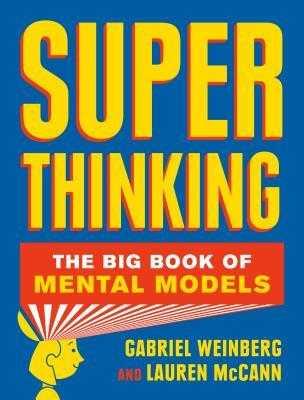Caroline V.'s Key Ideas from Super Thinking: The Big Book of Mental Models
by Gabriel Weinberg, Lauren McCann
Ideas, facts & insights covering these topics:
20 ideas
·49.8K reads
258
2
Explore the World's Best Ideas
Join today and uncover 100+ curated journeys from 50+ topics. Unlock access to our mobile app with extensive features.
First Principles Thinking
Thinking about a problem from an inverse perspective can unlock new solutions and strategies.
The central mental model to help you become a chef with your thinking is arguing from first principles. It’s the practical starting point to being wrong less, and it means thinking from the bottom up, using basic building blocks of what you think is true to build sound (and sometimes new) conclusions.
First principles are the group of self-evident assumptions that make up the foundation on which your conclusions rest—the ingredients in a recipe or the mathematical axioms that underpin a formula.
662
8.01K reads
De-Risking: Testing Your Assumptions
When arguing from first principles, you are deliberately starting from scratch. You are explicitly avoiding the potential trap of conventional wisdom, which could turn out to be wrong.
To be wrong less, you need to test your assumptions in the real world, a process known as de-risking. There is a risk that one or more of your assumptions are untrue, and so the conclusions you reach could also be false.
The next step is actually going out and testing these assumptions, proving or disproving them, and then adjusting your strategy appropriately.
620
4.87K reads
Ockham’s Razor
Ockham’s razor advises that the simplest explanation is most likely to be true. Look at your explanation of a situation, break it down into its constituent assumptions, and for each one, ask yourself: Does this assumption really need to be here? What evidence do I have that it should remain? Is it a false dependency?
Overfitting occurs when you use an overly complicated explanation when a simpler one will do. It’s what happens when you don’t heed Ockham’s razor, when you get sucked into the conjunction fallacy or make a similar unforced error.
644
4.38K reads
Your Frame Of Reference
If you’re trying to be as objective as possible when making a decision or solving a problem, you always want to account for your frame of reference. A frame-of-reference mental trap is framing.
Framing refers to the way you present a situation or explanation. You will of course be influenced by your perspective, but you don’t want to be unknowingly influenced.
If you think you may not have the full understanding of a situation, then you must actively try to get it by looking from a variety of different frames of reference.
607
3.3K reads
The Unconcious Mental Models
Nudging: You can be nudged in a direction by a subtle word choice or other environmental cues.
Anchoring: The tendency to rely too heavily on first impressions when making decisions.
Availability bias: This occurs when a bias, or distortion, creeps into your objective view of reality thanks to information recently made available to you. Further, the availability bias stems from overreliance on your recent experiences within your frame of reference, at the expense of the big picture.
609
3.1K reads
Understanding Other's Point Of View
Consequently, to be wrong less when thinking about people, you must find ways to increase your empathy, opening up a deeper understanding of what other people are really thinking.
In any conflict between two people, there are two sides to the story. Then there is the third story, the story that a third, impartial observer would recount.
Forcing yourself to think as an impartial observer can help you in any conflict situation, including difficult business negotiations and personal disagreements.
603
2.44K reads
If you can coherently articulate other points of view, even those directly in conflict with your own, then you will be less likely to make biased or incorrect judgments.
GABRIEL WEINBERG
620
3.9K reads
Hanlon's Razor and the Fundamental Attribution Error
Most respectful interpretation(MRI): In any situation, you can explain a person’s behavior in many ways. MRI asks you to interpret the other parties’ actions in the most respectful way possible.
Hanlon’s razor invites you to never attribute to malice that which is adequately explained by carelessness.
The third story, most respectful interpretation, and Hanlon’s razor are all attempts to overcome what psychologists call the fundamental attribution error, where you frequently make errors by attributing others’ behaviors to their internal, or fundamental, motivations rather than external factors.
613
2.24K reads
The Notorious Confirmation Bias
The veil of ignorance holds that when thinking about how society should be organized, we should do so by imagining ourselves ignorant of our particular place in the world, as if there were a veil preventing us from knowing who we are.
The human tendency to gather and interpret new information in a biased way to confirm preexisting beliefs is called confirmation bias.
Confirmation bias is so hard to overcome that there is a related model called the backfire effect that describes the phenomenon of digging in further on a position when faced with clear evidence that disproves it.
596
1.82K reads
Holding Two Different Beliefs Together
You may also succumb to holding on to incorrect beliefs because of disconfirmation bias, where you impose a stronger burden of proof on the ideas you don’t want to believe.
The pernicious effects of confirmation bias and related models can be explained by cognitive dissonance, the stress felt by holding two contradictory, dissonant, beliefs at once.
A real trick to being wrong less is to fight your instincts to dismiss new information and instead embrace new ways of thinking and new paradigms.
590
1.72K reads
Overcoming Confirmation Bias
Thinking Gray: You may think about issues in terms of black and white, but the truth is somewhere in between, a shade of gray. A truly effective leader, however, needs to be able to see the shades of gray inherent in a situation in order to make wise decisions as to how to proceed.
Devil’s advocate: Playing the Devil’s advocate means taking up an opposing side of an argument, even if it is one you don’t agree with. One approach is to force yourself literally to write down different cases for a given decision or appoint different members in a group to do so.
591
1.53K reads
Anything That Can Go Wrong, Will
In any situation where you can spot spillover effects (like a polluting factory), look for an externality (like bad health effects) lurking nearby.
Fixing it will require intervention either by fiat (like government regulation) or by setting up a marketplace system according to the Coase theorem (like cap and trade).
Beware of situations with asymmetric information, as they can lead to principal-agent problems.
576
1.62K reads
Spend Your Time Wisely
- Choose activities to work on based on their relevance to your north star.
- Focus your time on just one of these truly important activities at a time (no multitasking!), making it the top idea on your mind.
- Select between options based on opportunity cost models.
- Use the Pareto principle to find the 80/20 in any activity and increase your leverage at every turn.
- Recognize when you’ve hit diminishing returns and avoid negative returns.
- Use commitment and the default effect to avoid present bias, and periodic evaluations to avoid loss aversion and the sunk-cost fallacy.
609
1.47K reads
Becoming One with Nature
Adopt an experimental mindset, looking for opportunities to run experiments and apply the scientific method wherever possible.
Respect inertia: create or join healthy flywheels; avoid strategy taxes and trying to enact change in high-inertia situations unless you have a tactical advantage such as the discovery of a catalyst and a lot of potential energy.
When enacting change, think deeply about how to reach critical mass and how you will navigate the technology adoption life cycle.
Actively cultivate your luck surface area and put in work needed to not be subsumed by entropy.”
582
1.25K reads
Lies, Damned Lies, and Statistics
- Avoid succumbing to the gambler’s fallacy or the base rate fallacy.
- Anecdotal evidence and correlations you see in data are good hypothesis generators, but correlation does not imply causation—you still need to rely on well-designed experiments to draw strong conclusions.
- Look for tried-and-true experimental designs, such as randomized controlled experiments or A/B testing, that show statistical significance.
- The normal distribution is particularly useful in the experimental analysis due to the central limit theorem.
580
1.29K reads
Decisions, Decisions
- When tempted to use a pro-con list, consider upgrading to cost-benefit analysis or decision tree as appropriate.
- When making any quantitative assessment, run a sensitivity analysis across inputs to uncover key drivers and appreciate where you may need to seek greater accuracy in your assumptions. Pay close attention to any discount rate used.
- Beware of black swan events and unknown unknowns. Use systems thinking and scenario analysis to more systematically uncover them and assess their impact.
591
1.2K reads
Dealing with Conflict
- Analyze conflict situations through a game-theory lens. Look to see if your situation is analogous to common situations like the prisoner’s dilemma, ultimatum game, or war of attrition.
- Consider how you can convince others to join your side by being more persuasive through the use of influence models like reciprocity, commitment, liking, social proof, scarcity, and authority. And watch out for how they are being used on you, especially through dark patterns.
- Think about how a situation is being framed and whether there is a way to frame it that better communicates your point of view.
595
1.11K reads
Unlocking People’s Potential
People are not interchangeable. They come from a variety of backgrounds and with a varied set of personalities, strengths, and goals. To be the best manager, you must manage the person, accounting for each individual’s unique set of characteristics and current challenges.
Craft unique roles that amplify each individual’s strengths and motivations. Promote people only to roles in which they can succeed.
583
1.14K reads
Flex Your Market Power
- Find a secret and build your career or organization around it, searching via customer development for product/market fit (or another “fit” relevant to the situation).
- Strive to be like a heat-seeking missile in your search for product/market fit, deftly navigating the idea maze. Look for signs of hitting a resonant frequency for validation.
- If you can’t find any bright spots in what you’re doing after some time, critically evaluate your position and consider a pivot.
578
1.23K reads
IDEAS CURATED BY
I am a sucker for gadgets, stubborn and curious. Eating right and sleeping well is important to me.
CURATOR'S NOTE
Super Thinking is about the frameworks and shortcuts top performers rely on the cut through complexity and separate good ideas from bad ones.
“
Caroline V.'s ideas are part of this journey:
Learn more about problemsolving with this collection
Strategies for promoting inclusivity
How to address unconscious bias
How to create a diverse and inclusive workplace
Related collections
Discover Key Ideas from Books on Similar Topics
2 ideas
How to Ask for Help When You Need It Most
lifehack.org
8 ideas
The Power of Neuroplasticity
Shad Helmstetter Ph.d.
13 ideas
Think in Systems
Zoe McKey
Read & Learn
20x Faster
without
deepstash
with
deepstash
with
deepstash
Personalized microlearning
—
100+ Learning Journeys
—
Access to 200,000+ ideas
—
Access to the mobile app
—
Unlimited idea saving
—
—
Unlimited history
—
—
Unlimited listening to ideas
—
—
Downloading & offline access
—
—
Supercharge your mind with one idea per day
Enter your email and spend 1 minute every day to learn something new.
I agree to receive email updates




















